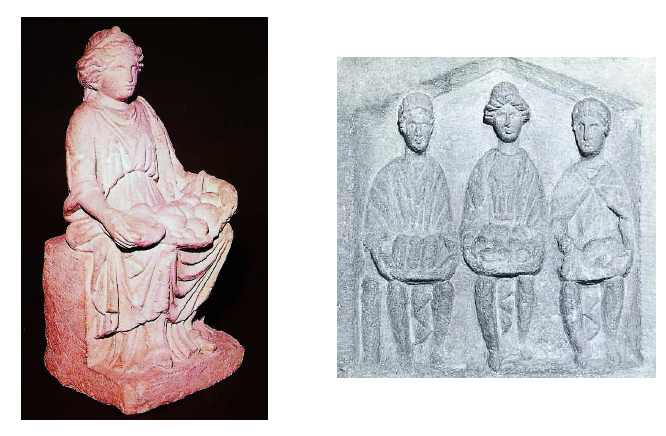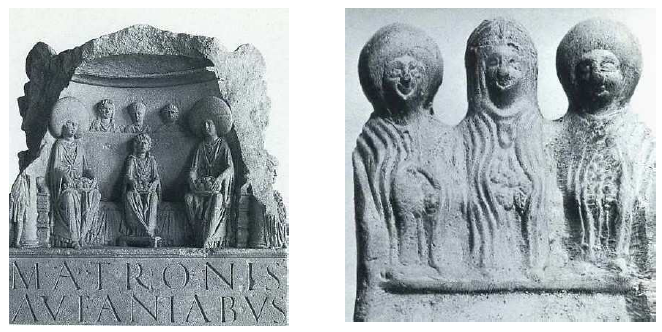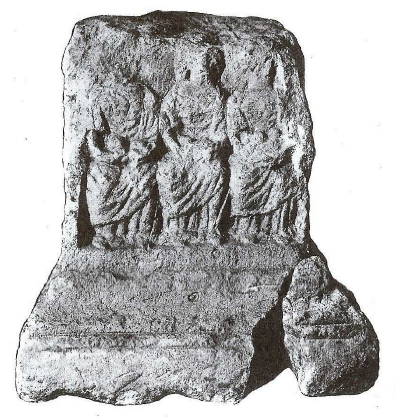A) Classical attributes
They are conventionally represented in a sitting posture, most of the time in an aediculum* - occasionally with a footstool under their feet – and wearing long garments and diadems on their hair, which is the expression of their magnificence, majesty and sovereignty. Besides, the Roman title Augustae is sometimes given to them in the dedications, such as in Vienne: Matris Augustis, C. Titius Sedulus ex voto, ‘To the August Mothers, C. Titius Sedulus offered (this)’.354 This title enhances their power and majesty and gives an official dimension to them.
The Mothers traditionally bear the universal attributes of the Greco-Roman Terra Mater, such as horns of plenty, eggs, loaves of bread, baskets of fruit, cereal head dresses or cakes, small animals, all representing the abundance of the products of the Earth which they literally embody. These attributes emphasize their life-giving propensities. A statue discovered in Alésia (Côte d’Or) depicts for instance a single seated goddess, with a long tunic and a tiara, holding a large basket containing a dozen pieces of fruit of various sizes in her lap (fig. 10).355 Another instance is the plaque from Cirencester (Gloucestershire, GB), representing three seated mothers, wearing coats and tunics. The one on the left holds a tray of cakes and loaves in her lap, while the two others on the right hold trays of fruit (fig. 10).356 As for the Germanic Mother Goddesses, they can be distinguished by the characteristic round hat they generally wear, such as on the relief* of the Matronae Aufaniae discovered in Bonn (Germany) and the pipe-clay figurine from Bonn representing three small Mothers holding fruit on their knee (fig. 11).357
It is clear that all these attributes of human and earthly fertility are quite common and imitate the religious Greco-Roman images. Thus, the figurative representation of those Mother Goddesses is not Celtic in character. Nonetheless, Simone Deyts argues that, if the attributes are borrowed from Classical representations, the statues are of indigenous character, for they were made in Gaul by local artisans and sculpted in regional material, such as limestone, terracotta or bronze.358
Epigraphy accompanies the imagery but rarely, and these testimonies are thus of great importance. The bas-relief* from Lyons, for instance, shows three small goddesses sitting and holding cornucopiae* and baskets of fruit in their laps, under which is engraved the following inscription: Matr(is) Aug(ustis) Phlegon med(icus), ‘To the Mother Goddesses, Phlegon doctor (offered this)’ (fig. 12).359 Similarly, another damaged altar, discovered in Fourvière (the hill overlooking Lyons) in 1895, depicts three Mothers sitting, wearing long tunics and coats, and each holding baskets of fruit on her knee (fig. 13).360 Along with this altar was found a tablet in white limestone bearing the inscription: Matr[is Aug(ustis)] P. Mattius Qua[rtus], L. Mattius Satto, C. Mattius Vitalis, ex voto, ‘To the August Mothers, P. Mattius Quartus, L. Mattius Satto (and) C. Mattius Vitalis offered (this monument)’.361



